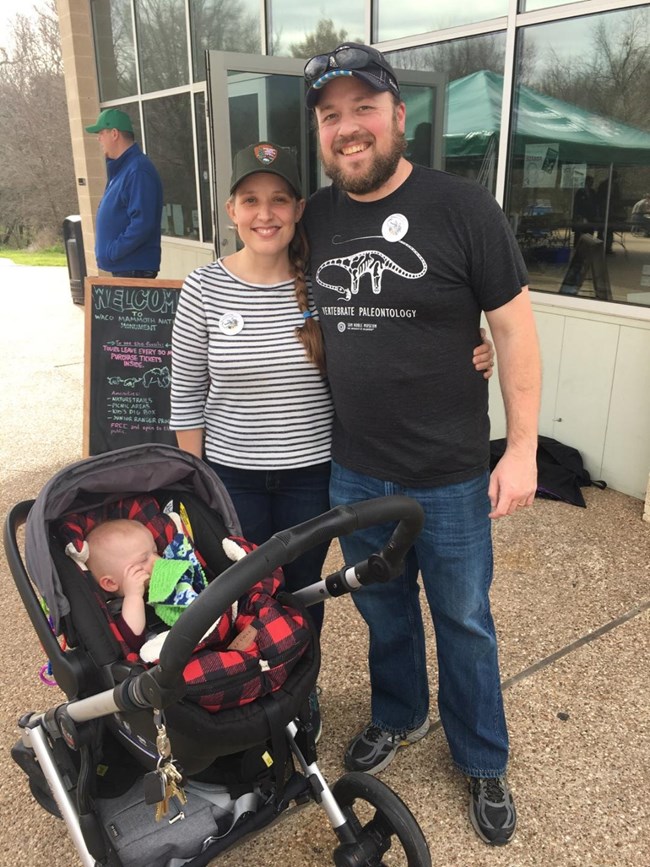Part of a series of articles titled Park Paleontology News - Vol. 12, No. 1, Spring 2020.
Article
First Paleontologist Hired at Waco Mammoth National Monument

Lindsey Yann, Paleontologist
Waco Mammoth National Monument, Texas
Hello! I am Lindsey Yann, and I have the wonderful honor of being the first paleontologist at Waco Mammoth National Monument. I am new to the NPS, so I have spent the last 6 weeks getting to know the Park Service and the resources here in Waco. These fossils are awe-inspiring!

NPS photo.
I grew up in southwestern Virginia, and had an early love for the outdoors, fossils, and national parks. My family camped and backpacked in the Great Smoky Mountains every summer until I graduated high school. Those mountains are still my happy place! In middle school and high school, I had the opportunity to help the Virginia Museum of Natural History excavate whales, dolphins, and fishes from the middle Miocene Calvert Formation north of Richmond, VA and small reptiles, insects, and plants from the Triassic Cow Branch Formation on the VA-NC boarder. Staying close to home, I earned my dual degree B.S. in Geosciences and Biological Sciences from Virginia Tech. I then headed down to Louisiana State University, where I earned an M.S. in Geological Sciences. At LSU I worked under Judith Schiebout, and my project used rare earth elements to determine the original source of fossils collected in the creeks within the Tunica Hills, LA. I finished up my formal education with a Ph.D. from Vanderbilt University where I worked with advisor Larisa DeSantis. My research focused on using stable isotope analysis from mammalian teeth to reconstruct climate and environment at different sites during the Pleistocene. Using this geochemistry, we were able to examine dietary modifications and community responses to climate change. Focusing on camelids, I was used an aridity index to separate the influences of temperature and precipitation on stable oxygen isotope values. Even when the necessary geology is lacking, this technique allows us to compare sites and determine if the animals lived during an interglacial or glacial period. I am currently using these same techniques to look at modern mammals across the globe and Miocene mammals from California.

Photo—Lindsey Yann.
While I am new to the park service, I did use one summer during my Ph.D. to do a GeoCorps Internship at Florissant Fossil Beds National Monument with Herb Meyer. I worked on educational and outreach material and helped the other interns and staff pack specimens that were being moved into the new visitor center. I graduated from Vanderbilt in 2014 and spent the last five years working as a senior research assistant at Oklahoma State University’s Center for Health Sciences in Tulsa, OK. I assisted five faculty on a variety of projects and helped conduct field work in the Morrison Formation of western Oklahoma and the Cretaceous Two Medicine Formation of Montana. While I enjoyed learning and working on this dinosaur material, dinosaurs weren’t my first love. I’m so excited to be working on Pleistocene material again!
In addition to learning the ropes of the NPS, I am also getting to know the partnership that makes the Waco Mammoth National Monument unique. The monument was established in July 2015 and functions as a partnership between the park service, the City of Waco, the Waco Mammoth Foundation, and Baylor University. As I get settled into this position, I will be working with each of these entities to help develop the new paleontological program. The federal government owns just shy of five acres, but the city owns an additional 100+ acres that still needs to be investigated. We need to work with researchers and other park staff to survey and develop management plans for the 105+ acres. We already know fossil material is washing out in some small ravines, and it looks like we might have another camel! There is a lot of work ahead of us, but I am excited to get dirty and build this program!
Last updated: February 6, 2023
